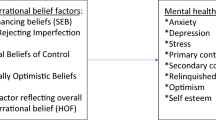Abstract
The present study investigated the relationship between hostility, belief systems, coping styles, and illness. Hostility is of interest when considering the stress-illness relationship because it has been associated with increased risk for coronary heart disease as well as general mortality. The results suggest that individuals prone toward hostility are more likely to succumb to illness and adhere to irrational beliefs than individuals not so oriented. In addition, hostile individuals were found to employ different, and perhaps less adaptive, coping styles than their low hostility counterparts. It was concluded that the belief systems and coping styles typically employed by individuals prone toward hostility may be important mediating variables in the relationship between hostility and illness. These factors may also be important to take into account in treatment programs designed to reduce illness risks for such individuals. Finally, this study suggests that stress-induced impairment of health for hostility-prone individuals may begin much earlier than the vast majority of the literature currently suggests.
Similar content being viewed by others
References
Barefoot, J. C., Dahlstrom, W. G., & Williams, R. B., Jr. (1983). Hostility, CHD incidence, and total mortality: A 25-year follow-up study of 255 physicians.Psychosomatic Medicine, 45, 59–63.
Barefoot, J. C., Williams, R. B., Jr., Dahlstrom, W. G., & Dodge, K. A. (1987). Predicting mortality from scores on the Cook-Medley Scale: A follow-up of 118 lawyers.Psychosomatic Medicine, 49, 210.
Berkman, L., & Syme, S. L. (1979). Social networks, host resistance, and mortality: A nine-year follow-up study of Alameda County residents.American Journal of Epidemiology, 109, 186–204.
Burke, R. J. (1985). Beliefs and fears underlying Type A behavior: Correlates of time urgency and hostility.Journal of General Psychology, 112, 133–145.
Cook, W. W., & Medley, D. M. (1954). Proposed hostility and pharisaic-virtue scale for the MMPI.Journal of Applied Psychology, 38, 414–418.
Costa, P. T., Jr., Zonderman, A. B., McCrae, R. R., & Williams, R. B., Jr. (1986). Cynicism and paranoid alienation in the Cook and Medley Hostility Scale.Psychosomatic Medicine, 48, 283–285.
Defares, B. P. (1982, August).Coping with stress. Paper presented at the Workshop on Heart and Stress. Bilthoven, The Netherlands.
Dembroski, T. M., & Costa, P. T., Dr. (1987). Coronary-prone behavior: Components of the Type A pattern and hostility.Journal of Personality, 55, 211–235.
Dembroski, T. M., MacDougall, J. M., Herd, J. A., & Shields, J. L. (1983). Perspectives on coronary-prone behavior. In D. S. Krantz, A. Baum, & J. E. Singer (Eds.),Handbook of psychology and health (Vol. 3, pp. 57–81). Hillsdale, NJ: Lawrence Erlbaum Associates.
Dembroski, T. M., MacDougall, J. M., Williams, R. B., Jr., Haney, T. L. & Blumenthal, J. A. (1985). Components of Type A, hostility, and anger-in: Relationship to angiographic findings.Psychosomatic Medicine, 47, 219–233.
Folkman, S., & Lazarus, R. S. (1988).Manual for the Ways of Coping Questionnaire. Palo Alto: Consulting Psychologists Press.
Friedman, M. F., & Ulmer, D. (1984).Treating Type A behavior and your heart. New York: Fawcett Crest.
Hogg, J. A., & Deffenbacher, J. L. (1986) Irrational beliefs, depression, and anger among college students.Journal of College Student Personnel, 27, 349–353.
House, J., Robbins, C., & Metzner, H. (1982). The association of social relationships and activities with mortality: Prospective evidence from the Tecumseh Community Health Study.American Journal of Epidemiology, 116, 123–140.
Houston, B. K. (1986). Psychosocial variables and cardiovascular and neuroendocrine reactivity. In K. A. Matthews, S. M. Weiss, T. Detre, T. M. Dembroski, B. Falkner, S. B. Manuck, & R. B. Williams, Jr. (Eds.),Handbook of stress, reactivity, and cardiovascular disease (pp. 207–229). New York: John Wiley and Sons.
Houston, B. K., & Kelley, K. E. (1989). Hostility in employed women: Relation to work and marital experience, social support, stress, and anger expression.Personality and Social Bulletin, 15, 178–193.
Jenkins, C. D., Rosenman, R. H., & Zyzanski, S. J. (1974). Prediction of clinical coronary heart disease by a test for the coronary-prone behavior pattern.New England Journal of Medicine, 290, 1271–1275.
Jones, R. G. (1969).The irrational beliefs test, Wichita, KN: Test Systems.
Lazarus, R. S., & Folkman, S. (1984).Stress, appraisal, and coping. New York: Springer.
Martin, R. A., Kuiper, N. A., & Westra, H. A. (1989). Cognitive and affective components of the Type A behavior pattern: Preliminary evidence for a self-worth contingency model.Personality and Individual Differences, 10, 771–784.
Matthews, K. A. (1988). CHD and Type A behaviors: Update on and alternative to the Booth-Kewley and Friedman quantitative review.Psychological Bulletin, 104, 373–381.
Review Panel on Coronary-Prone Behavior and Coronary Heart Disease (1981). Coronary-prone behavior and coronary heart disease: A critical review.Circulation, 63, 1199–1215.
Shekelle, R. B., Gale, M., Ostfeld, A. M., & Paul, O. (1983). Hostility, risk of coronary heart disease, and mortality.Psychosomatic Medicine, 45, 109–114.
Smith, T. W., & Frohm, K. D. (1985). What’s so unhealthy about hostility? Construct validity and psychosocial correlates of the Cook and Medley Ho Scale.Health Psychology, 4, 503–520.
Smith, T. W., Pope, M. K. (1990). Cynical hostility as a health risk: Current status and future directions.Journal of Social Behavior and Personality, 5, 77–87.
VanderVoort, D. J. (1990). Hostility, coping styles, belief systems, and illness.Dissertation Abstracts International.
Vickers, R. R., Jr., Hervig, L. K., Rahe, R. H., & Rosenman, R. H. (1981). Type A behavior pattern and coping and defense.Psychosomatic Medicine, 43, 381–396.
Vingerhoets, A. J., & Flohr, P. J. (1984). Type A behavior and self-reports of coping preferences.British Journal of Medical Psychology, 57, 15–21.
Williams, R. B., Jr., Haney, T. L., Lee, K. L., Kong, Y., Blumenthal, J. A., & Whelan, R. E. (1980). Type A behavior, hostility, and coronary atherosclerosis.Psychosomatic Medicine, 42, 539–549.
Author information
Authors and Affiliations
Rights and permissions
About this article
Cite this article
Vandervoort, D.J. Belief systems and coping styles as mediating variables in the relationship between hostility and illness. Current Psychology 11, 226–235 (1992). https://doi.org/10.1007/BF02686842
Accepted:
Issue Date:
DOI: https://doi.org/10.1007/BF02686842




